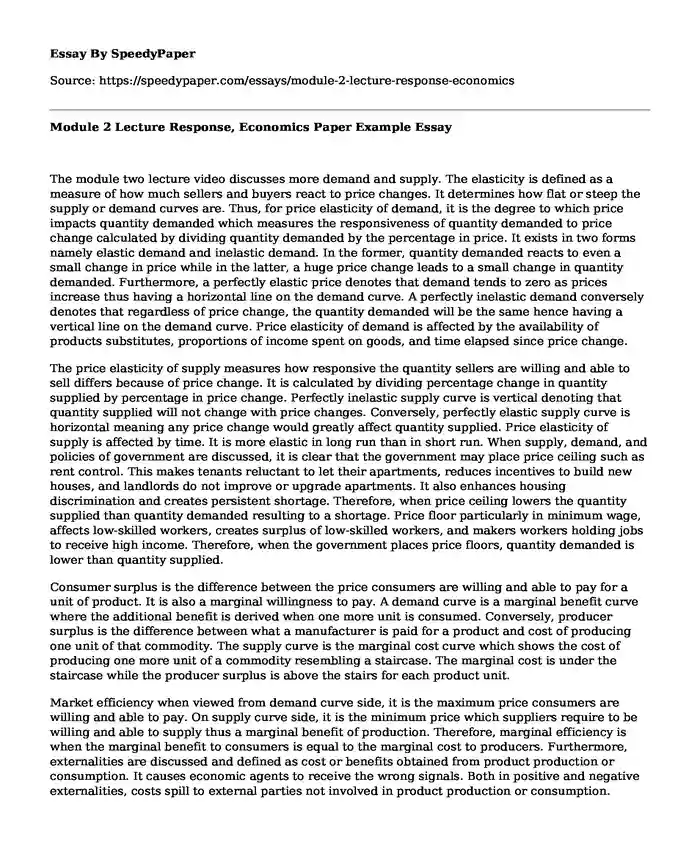The module two lecture video discusses more demand and supply. The elasticity is defined as a measure of how much sellers and buyers react to price changes. It determines how flat or steep the supply or demand curves are. Thus, for price elasticity of demand, it is the degree to which price impacts quantity demanded which measures the responsiveness of quantity demanded to price change calculated by dividing quantity demanded by the percentage in price. It exists in two forms namely elastic demand and inelastic demand. In the former, quantity demanded reacts to even a small change in price while in the latter, a huge price change leads to a small change in quantity demanded. Furthermore, a perfectly elastic price denotes that demand tends to zero as prices increase thus having a horizontal line on the demand curve. A perfectly inelastic demand conversely denotes that regardless of price change, the quantity demanded will be the same hence having a vertical line on the demand curve. Price elasticity of demand is affected by the availability of products substitutes, proportions of income spent on goods, and time elapsed since price change.
The price elasticity of supply measures how responsive the quantity sellers are willing and able to sell differs because of price change. It is calculated by dividing percentage change in quantity supplied by percentage in price change. Perfectly inelastic supply curve is vertical denoting that quantity supplied will not change with price changes. Conversely, perfectly elastic supply curve is horizontal meaning any price change would greatly affect quantity supplied. Price elasticity of supply is affected by time. It is more elastic in long run than in short run. When supply, demand, and policies of government are discussed, it is clear that the government may place price ceiling such as rent control. This makes tenants reluctant to let their apartments, reduces incentives to build new houses, and landlords do not improve or upgrade apartments. It also enhances housing discrimination and creates persistent shortage. Therefore, when price ceiling lowers the quantity supplied than quantity demanded resulting to a shortage. Price floor particularly in minimum wage, affects low-skilled workers, creates surplus of low-skilled workers, and makers workers holding jobs to receive high income. Therefore, when the government places price floors, quantity demanded is lower than quantity supplied.
Consumer surplus is the difference between the price consumers are willing and able to pay for a unit of product. It is also a marginal willingness to pay. A demand curve is a marginal benefit curve where the additional benefit is derived when one more unit is consumed. Conversely, producer surplus is the difference between what a manufacturer is paid for a product and cost of producing one unit of that commodity. The supply curve is the marginal cost curve which shows the cost of producing one more unit of a commodity resembling a staircase. The marginal cost is under the staircase while the producer surplus is above the stairs for each product unit.
Market efficiency when viewed from demand curve side, it is the maximum price consumers are willing and able to pay. On supply curve side, it is the minimum price which suppliers require to be willing and able to supply thus a marginal benefit of production. Therefore, marginal efficiency is when the marginal benefit to consumers is equal to the marginal cost to producers. Furthermore, externalities are discussed and defined as cost or benefits obtained from product production or consumption. It causes economic agents to receive the wrong signals. Both in positive and negative externalities, costs spill to external parties not involved in product production or consumption. However, private market supplies too little and too much of product in positive and negative externality respectively. Therefore, this discussion is essential in comprehending how demand and supply work and factors affecting them in the market.
Cite this page
Module 2 Lecture Response, Economics Paper Example. (2022, Jun 17). Retrieved from https://speedypaper.com/essays/module-2-lecture-response-economics
Request Removal
If you are the original author of this essay and no longer wish to have it published on the SpeedyPaper website, please click below to request its removal:
- Essay Example on the Impact of Jim Crow Laws on African Americans
- What Is the Definition of Altruism. Essay Sample.
- Leader Profile Essay Sample
- Essay Sample: Mycobacterium Tuberculosis Research
- Free Essay: Slavery, Race, and Racism
- Paper Example on Behaviorism Theory
- Paper Example on Race and Technology
Popular categories





